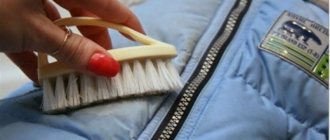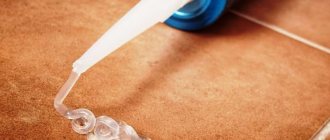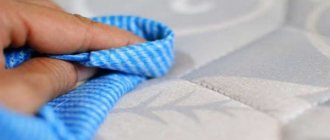Ceramic sinks are very popular and in demand. Practical and beautiful, they are characterized by resistance to wear and durability. However, many people believe that sinks made from this material are difficult to maintain. In fact, cleaning a ceramic sink is not a difficult task. The main thing is to choose the right composition and product for one type of dirt or another, and also follow simple recommendations for caring for the sink.
Safe products and tools
It is very easy to damage plumbing fixtures; for example, a brush that is too hard will leave small scratches. Therefore, you need to use some drugs and devices with caution:
- Do not use aggressive solutions or solvents, such as acetone, to clean plumbing fixtures. Such preparations will cause irreparable damage to the coating of products.
- Do not clean porcelain stoneware or ceramic sinks with steel wool, abrasive powders or hard brushes. This will lead to scratches on the surface of the plumbing fixtures.
- Sinks made of porcelain stoneware do not withstand exposure to contrasting temperatures. Therefore, you cannot pour boiling water into them, pour ice, etc.
- Do not use a knife to clean products.
By following these simple rules, you can protect your ceramic sink from damage.
Purchasing a highly effective cleaning product for a variety of plumbing fixtures is not difficult. The assortment presented in stores is wide and varied. However, you need to choose cleaning compounds wisely. Not every one of them is suitable for cleaning ceramic and porcelain stoneware sinks:
- Chlorine-containing products. They perfectly remove stains, whiten the surface, and disinfect. Therefore, they should be used for cleaning light-colored items.
- A variety of detergents intended for washing dishes. Such preparations will ideally remove fat and microbiological plaque from surfaces. However, they will not be able to help in the fight against stubborn dirt.
Before purchasing a cleaning product, you need to carefully study its composition. Do not use products containing methyl chloride and various solvents to clean ceramic and porcelain stoneware sinks. Such drugs can cause irreparable damage to the coating.
Lemon and soda not only remove dirt, but also prevent corrosion.
To clean the sink and remove various contaminants, it is not at all necessary to have a cleaning product from the store on hand. The usual compounds found in every kitchen will help you clean the product. Most housewives know and use them well for cleaning plumbing fixtures and other various products:
- Mustard powder is often used to degrease surfaces. To do this, mix mustard powder with a small amount of water. Apply the resulting slurry to the sink and rinse with water after 5 minutes. You can use this composition daily; it will not damage the coating.
- Lemon juice will help remove stubborn stains from coffee and tea from the surface, whiten the sink, and give it a pleasant, refreshing smell.
- Baking soda is a very effective remedy. It will help remove any dirt from the surface of products, even stubborn ones. The product perfectly whitens the coating and destroys all microbes. Before cleaning the sink, you need to mix soda with a small amount of water, apply the resulting slurry to the surface and leave. After 10 minutes, rinse the product thoroughly with water.
- Toothpaste. Gel compounds are used to clean the sink. The paste perfectly refreshes the surface, copes with various contaminants, and brightens the coating. Therefore, it is most often used to clean light-colored products.
- Vinegar is an effective tool for removing limescale deposits. To do this, you need to prepare a solution: mix vinegar and water in equal proportions, apply the resulting composition to the product. After 10 minutes, rinse the sink thoroughly, then wipe dry with a paper towel or soft cloth.
So, folk remedies will help cope with any pollution. The undoubted advantage of such compositions is the budget price. In addition, they do not contain harmful substances.
What household chemicals can be used
On store shelves you can find a wide variety of chemical compounds that can be used to clean a ceramic sink. Cleaning a ceramic sink is carried out with proven products that will remove dirt and debris and will not lead to the formation of scratches and cracks on the surface. Choose detergents by carefully studying the composition.
How to clean a ceramic kitchen sink every day:
Porcelain stoneware sinks
A relatively new material in the manufacture of kitchen sinks is porcelain stoneware. The composite material consists of 80% granite chips. The rest is made up of polymer binders. Such sinks are often classified as stone products due to the presence of crushed granite in the composition. With their color scheme they resemble various types of natural stone.
Kitchen sinks made of porcelain stoneware are immune to high temperatures and mechanical damage, absorb sounds from flowing water and are resistant to alkali-containing products. Cleaning a porcelain stoneware sink is simple: for this purpose, use a soap solution or liquid detergents.
Ceramic sinks will not only protect against high temperatures and scratches, but will also highlight the interior of your kitchen.
We suggest you familiarize yourself with Unpleasant smell from things in the closet
A little about security
Before starting work on cleaning the sink, regardless of its type, be sure to wear gloves. All detergents contain substances that irritate the skin to a greater or lesser extent. When working with vinegar, you need to be especially careful, especially when using it in concentrated form. It would be useful to use a respirator and safety glasses.
It is always easier to carry out preventive work than to deal with the consequences. Therefore, you should not run the car wash until it is in an emergency condition. It is enough to do a little preventive cleaning once a week using the most gentle products; the sink will delight the eye with its cleanliness for a long time.
Folk remedies
Use available products to clean the ceramic sink. The main ones are presented in the table:
| Means | Possibilities |
| Lemon | Brightens the surface, cleanses microbiological contamination |
| Mustard powder | Suitable for daily use for easy surface cleaning |
| Baking soda | Removes germs and slows down their proliferation, and also removes tea and coffee stains |
| Toothpaste | Slightly whitens the surface and refreshes the appearance |
| Vinegar | Removes traces of limestone |
| Dishwasher tablets | Removing rust and limestone stains |
All types of home remedies have a single application algorithm for cleaning porcelain stoneware sinks. First, apply the required mixture to the entire area of the sink and leave for 5 minutes. If there are stubborn stains, it is recommended to wait 10 to 15 minutes after applying the product. Afterwards, you need to thoroughly wash the porcelain tile sink in the kitchen using a soft dish sponge or a cloth rag.
Features of removing stains from the surface of porcelain stoneware
Caring for a sink made of natural stone sometimes feels like walking through a minefield - make a slight mistake, and a disastrous result will not be long in coming. How to clean a porcelain stoneware sink without negative consequences?
You can choose the product by determining what type of stain you are dealing with. Persistent contaminants occurring on the surface of natural stone can be classified according to several criteria:
- White plaque. Stains appear on the surface of dark sinks if tap water contains a lot of chlorine. You can deal with them using a mixture of chalk and hydrogen peroxide (1:1), which is applied to the surface and left for a couple of minutes, for better whitening of deep layers;
- Dark coating, rust. Such stains appear on the surface of the shell in regions with high iron content in the water. They are removed using strong chemicals;
- Water marks. Most often they appear on the surface of light-colored shells. They can be dissolved using an vinegar-soda suspension;
- Stains from natural dyes. They are usually the most stable. For example, blueberry juice is absorbed into the surface of a light sink in 5-10 minutes, penetrating into the micropores of the stone. To remove them, use the professional products indicated in the table;
- Varnish, paint. Such pollution is the least typical for the kitchen. But, if there is a need to remove stains, you will have to take a risk. To remove traces of artificial dyes from the surface of the sink, take an acetone-based solvent and apply it pointwise to the stain using cotton wool. Then quickly wash it.
It might be interesting: Getting to know the siphon for a kitchen sink with overflow
Pros and cons of ceramic kitchen sinks
When thinking about purchasing a ceramic sink, first of all you should decide what type of material you prefer: porcelain or earthenware.
- The earthenware sink contains third-party additives that reduce the cost of the product. However, because of this, quality suffers. The porosity of the material increases, which promotes intensive absorption of odors and moisture. To increase their service life, earthenware sinks are coated with glaze, which has protective and decorative functions. Often this coating differs in color from the inner filling of the sink. Therefore, repairing a faience sink when chips or cracks appear is a complex and irrational matter. In this case, professionals recommend changing the product.
- A porcelain sink is made using a slightly different technology, as a result of which it has a dense structure. It is resistant to mechanical damage and high temperatures. The cost of porcelain sinks is often higher than earthenware.
Ceramic sinks have numerous pros and cons during operation, which you should familiarize yourself with before making a purchasing decision.
Removing limescale
The water in most regions of our country is very hard, so after using it, limescale remains on the plumbing equipment. To remove it from a ceramic sink, use the following means:
- Chlorine-containing compounds can be used once a week. To do this, close the drain hole and pour hot water with the product into the sink for 20-30 minutes. Afterwards, the solution is drained and the sink is rinsed.
- Fabric bleach can be used once every 2 weeks. Before use, it is diluted with water, the amount of which is three times larger. For convenience, the solution can be poured into a spray bottle, spread over the surface of the ceramic sink and left overnight. Wash the sink with running water.
- Limescale deposits can be easily removed with acid (do not use on artificial ceramics). On the farm, this can be citric acid or vinegar. You can spray it from a spray bottle for 3 minutes and rinse the sink with water. If plaque on any area is not washed off, apply a cloth soaked in vinegar to it for 15 minutes. This method can be used to clean a ceramic iron.
- Add ammonia to 200 ml of water. 1 teaspoon of ammonia is enough. Spray the solution and wash with warm water after 10 minutes.
We invite you to familiarize yourself with 5 ways to quickly remove odors from your refrigerator.
Unpleasant smell
A clean sink is only half the battle. Its shine will not please you if it emits unpleasant “odors.” Particles of food remain in the pipe, they begin to decompose - hence the smell. It is very persistent, but you can get rid of it in two proven ways:
- Vinegar + soda. 100 g of soda is poured into the drain and the same amount of table vinegar is poured. After this, a hiss will be heard and foam will begin to emerge from the pipe - this indicates the beginning of cleansing. After ten minutes, boiling water is poured into the drain, which should remove the accumulated dirt.
- Mole. This tool has been in demand for many decades, because it copes with the task. You just need to pour the required amount of the composition into the drain and fill it with water according to the instructions.
Installation
After purchasing a suitable ceramic sink for your kitchen, you should think about how to install it. There are three options here:
- Overhead sink. Installation of such a model does not require special knowledge and skills. A ceramic sink is installed on a cabinet or cabinet, replacing the countertop. The ideal option for installation are kitchen units consisting of individual modules of a suitable size. Most often, overhead sinks have a rectangular shape for ease of installation.
- The mortise model is more versatile. Due to the fact that it is mounted into a solid kitchen countertop, it can have any shape: square, round, non-standard. A hole is cut in the table surface according to the size of the sink into which it is installed. Mortise ceramic sinks are attached to the inner surface of the countertop using special brackets and screws. Mortise sink models have machined edges that close the hole in the countertop and prevent moisture from penetrating inside.
- Integrated sinks are installed according to the principle of mortise sinks, but have a fundamental difference: they are mounted at the same level as the countertop, without rising above it. Due to the need for perfect alignment of the sink with the table surface, it is better to entrust the installation method to professionals.
As for the placement, a ceramic sink is installed in the kitchen not only using the standard wall-mounted method. In small rooms it is rational to place a special corner sink. This will save space and ergonomically organize the work area. In a spacious kitchen, the cooking area can be located in the center of the room. An island option for placing a sink will be an additional decoration of the interior.
The ceramic sink is practical to use and maintain, and also looks incredibly stylish and attractive.
What is porcelain tile afraid of?
There is a saying, “Strong as granite.” The stone has become the standard of durability and reliability. It is used to construct buildings, to decorate embankments, and as a covering for pedestrian streets. But even durable granite has its weaknesses, which make it difficult to use as a coating for household plumbing.
Below are the problems encountered when using porcelain stoneware sinks:
- Chips. If chips, scratches or cracks appear on the surface of a sink made of this natural material, they become areas for stains to spread. Dirt absorbed under the protective coating quickly penetrates into the deep layers of porcelain stoneware;
- High absorption (absorption). Due to its fine-porous structure, natural stone absorbs various contaminants well. How to clean a porcelain stoneware sink in a kitchen in a similar situation? The best option for deep stains that evenly cover the entire surface are liquid products that can remove the stain not only on the surface, but also in deeper layers;
- Heat instability. If you place a hot frying pan or pot on the edge of the sink, greasy marks appear on the surface of the porcelain stoneware, which are very difficult to remove. There are no such problems with iron sinks;
- Destruction of the top layer when using abrasives and iron brushes. Mechanical cleaning is not permitted for porcelain stoneware sinks.
Preventive measures
It is necessary to prevent the formation of stains on stainless steel if possible. To do this, resort to the following prevention:
Do not leave leftover food inside the sink. After washing the dishes, you need to remove all pieces of food.
- Abrasives. They provoke scratches and are superior to available means, so you should not use them on a regular basis.
- Dirty dishes. You should wash it right away; you should make it a rule not to leave it in the sink overnight.
- Polishing. Once every two weeks, it is recommended to polish the sink with olive or vegetable oil - this will keep it shiny.
- Metal brushes. They may cause scratches on the surface.
Even severe stains on stainless steel should not cause horror. There are many ways to clean it. And useful tips will help you keep your kitchen clean, the main thing is to stick to them.
What and how to clean?
To clean the base of a ceramic sink, it is recommended to pay special attention to the following compounds:
A well-known detergent that can effectively care for ceramic surfaces. The positive qualities of Cillit Bang include gentle removal of dirt and complete absence of surface damage. However, the product cannot wash off very old marks the first time, so it will need to be used in 2-3 doses. Cillit Bang can be used 2-3 times a week.
Expensive, but a good detergent that removes greasy film and destroys all types of dirt that clog the pores of the sink. Mellerud washes away dirt and also prevents its appearance, while giving the stone a thin protective film. The only disadvantage of the product is its price, but Mellerud lasts a long time, so the cost can justify itself.
- Liquid used to care for glass.
We suggest you familiarize yourself with How to store pot lids in the kitchen conveniently and compactly - 5 super ways
How to clean a granite sink? A regular glass cleaner can help with this, removing any kind of dirt and giving porcelain stoneware shine and a slight gloss. The negative qualities of the liquid include the appearance of an unpleasant and sometimes pungent odor for an hour, which cannot be washed off until the amber itself disappears. Therefore, it is better to choose a “tasty” liquid that will emit a pleasant aroma during application and cleaning of ceramics.
It is recommended to use all of the above methods according to the instructions so that they do not disturb the appearance of the stone and do not cause its rapid deformation.
You can also use folk recipes for cleaning the sink and nearby tiles. For example, you can clean porcelain stoneware washbasins with soda and vinegar, which should be taken in equal quantities. After this, the mass is applied to the surface and distributed with gentle movements along the base of the sink. After a couple of minutes, the product is washed off with water and the surface is dried with a dry cloth.
It is recommended to use all of the above methods according to the instructions so that they do not disturb the appearance of the stone and do not cause its rapid deformation.
We suggest you familiarize yourself with how to remove brilliant green from leather. Plumbing fixtures must be regularly cleaned and kept clean.
You should wash your porcelain stoneware kitchen sink after each use and thoroughly wash it at least once a week. The following cleaning products are often used:
- Cream for glass ceramics Sillit Bang. It is easy to clean a granite sink with this product without damaging the surface. But the product does not remove old and stubborn stains well.
- Mellerud. Used as a preventative against stains. The disadvantage is the relatively high price.
- Glass cleaning liquid. This product can be chosen from any brand and used on a glossy surface after daily washing of dishes. The presence of an unpleasant odor for up to one hour is considered negative.
Daily care: rules
In order for a ceramic sink to maintain its aesthetics for a long time, it is important to regularly remove dirt from its surface. To accomplish this, water alone is not enough. For daily care it is worth using special chemicals (“Silit” or “Sif”). The best time to do this is at the end of the day, when tidying up the kitchen.
How to care for a ceramic sink? Basic daily rules include the advice to wipe dry after each use. To do this, you should get a special towel. It should be placed next to the sink. This way you will always have it at hand if you need to blot up moisture. You can make your daily care task easier by teaching your family members to wipe down the sink after themselves.
What is the difference?
A porcelain stoneware sink in the kitchen has a number of advantages, in contrast to standard iron or cast iron ones. In addition to its beautiful appearance, this type of sink has the following characteristics:
- noise resistance - when the water flow is turned on, no noise is created;
- ease of restoration in case of severe damage;
- environmental friendliness - the material is made from natural stone chips;
- low level of interaction with liquids that are often used in the kitchen;
- resistance to moisture - the pores of the material do not allow water to pass through.
A good quality that housewives like is the low rate of bacterial growth on the surface of the sink. If constant moisture is present, unpleasant odor and mucus will not form. It is possible to order your own design to match the kitchen interior, because such sinks are made by pressing crumbs with an adhesive solution. But there is also a drawback: the dishes easily hit the porcelain stoneware.
Preparation
Before you start cleaning your sink, be sure to do the following:
- Remove everything that bothers you.
- Be sure to wear rubber gloves!
- If you want to use chemicals, make sure to ventilate the room in advance.
- Clean the sink of large pieces of dirt, food, and hair in the drain.
- Make sure that brushes and sponges for cleaning sinks are not metal - these types are harmful to any type of sink!
- Do not use strong acidic, chloride or ammonia products - they are only applicable in small doses as part of a solution, and not in pure form!
Make it a habit to wear gloves when cleaning
Avoid metal jaws
How to clean a ceramic sink from dirt
How to wash a ceramic sink that has become dirty during use if an unpleasant coating has appeared on it? Recently, ceramic sinks have become widely known. And rightly so, because increased wear resistance, beauty, strength - all this attracts women.
But ceramics, like other types of materials from which sinks are made, tend to get dirty, so each owner is advised to know exactly what can be used to clean a ceramic sink. Such sinks do not release toxic substances into the air, do not oxidize or deform, but it is still necessary to choose the right cleaning products.
Moreover, it is important to clean and wash a ceramic sink carefully and regularly.
How to clean a porcelain stoneware sink
To give a special style to the interior, solidity and attractiveness, ceramic and porcelain stoneware sinks are increasingly being installed in the kitchen today. It is quite natural that the question arises of how to clean a porcelain stoneware sink.
This material is essentially an artificial stone, which is distinguished by excellent performance characteristics - thermal stability, hardness, wear resistance.
But such high technical characteristics of ceramics and porcelain stoneware can be maintained for a long time only if the surface is properly cared for.
Useful tips
To ensure that the cleansing procedure does not take much time, you must:
- Carefully select a cleaning agent for the material of the unit;
- Clean the walls of the device daily to avoid the accumulation of dirt;
- Use protective gloves when working with aggressive concentrates;
- To make the surface shine, you need to rub the product with olive oil or wax;
- Do not leave dirty dishes in the bowl for a long time.
Our tips will help you clean your kitchen sink from stubborn dirt.
We hope that these methods will be useful for caring for sinks and will answer the question of how to clean a sink at home.











